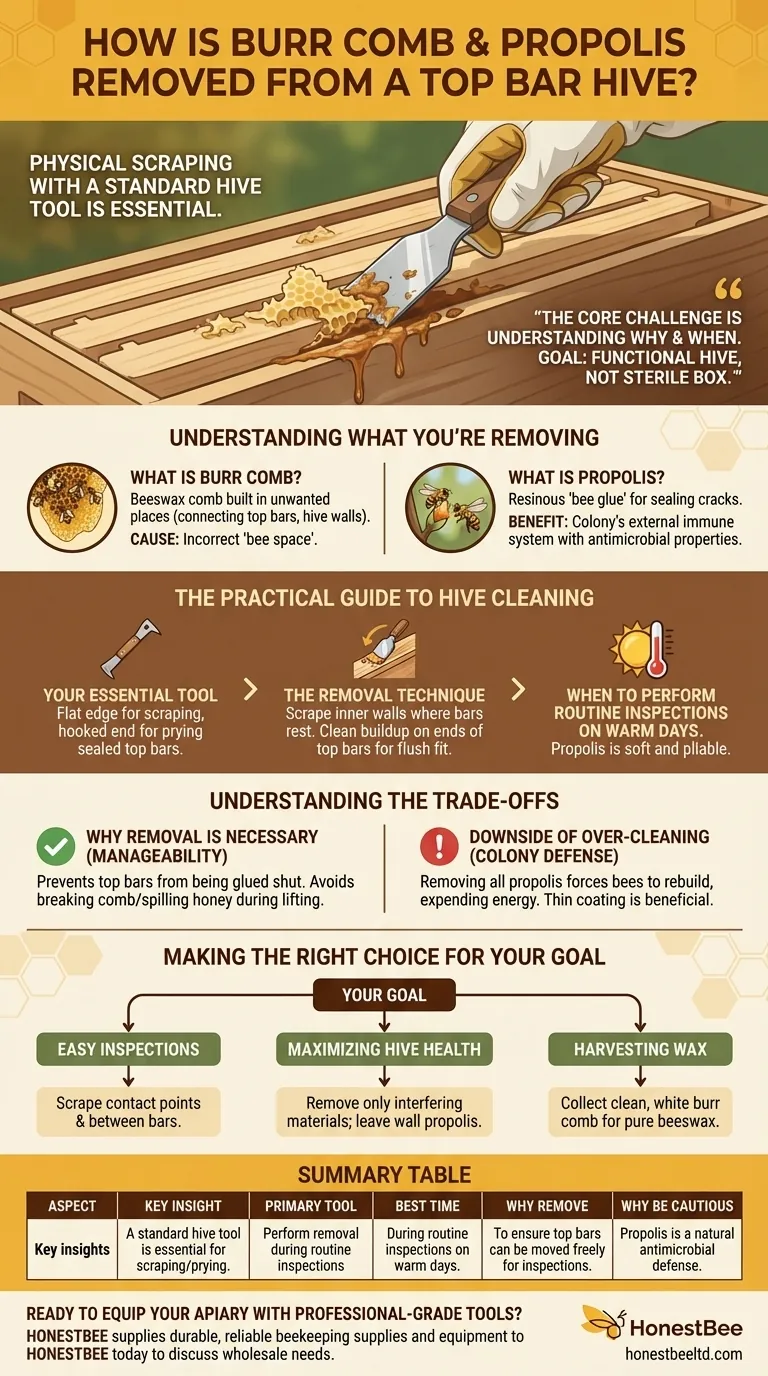In a top bar hive, burr comb and propolis are removed by physically scraping them from the hive walls and the ends of the top bars. The single most effective and common tool for this task is a standard hive tool, which provides the leverage needed to pop off propolis seals and scrape away unwanted wax.
The core challenge isn't the act of scraping, but understanding why and when to remove these materials. Your goal is not a sterile, clean box, but a functional hive where top bars can be moved freely for inspection without disrupting the colony's natural defenses.

Understanding What You're Removing
Before you begin scraping, it's crucial to understand the materials you're dealing with and why the bees create them. They are not signs of a problem, but rather a healthy, functioning colony shaping its environment.
What is Burr Comb?
Burr comb is simply beeswax comb built in a place the beekeeper doesn't want it. Bees will often build it to connect top bars together or attach them to the side of the hive cavity.
This happens most often when the "bee space"—the precise gap bees prefer to move through—is not correctly maintained.
What is Propolis?
Propolis, or "bee glue," is a resinous, sticky substance that bees collect from tree buds and other botanical sources. They use it to seal small cracks and gaps in the hive.
This serves a vital purpose, as propolis has powerful antimicrobial and antifungal properties, effectively acting as the colony's external immune system and protecting it from disease.
The Practical Guide to Hive Cleaning
Removing excess comb and propolis is a straightforward physical task that should be integrated into your regular hive inspections.
Your Essential Tool
The only tool you truly need is a hive tool. Its flat edge is perfect for scraping, while the hooked or bent end is ideal for prying up top bars that have been sealed tightly with propolis.
The Removal Technique
Focus your efforts on the points of contact. Use the flat edge of your hive tool to scrape along the inner walls of the hive where the ends of the top bars rest.
You should also clean any propolis buildup or burr comb from the ends of the top bars themselves. This ensures they sit flush and can be easily separated and lifted during an inspection.
When to Perform This Task
The best time to clean your hive is during a routine inspection on a warm day. When warm, propolis is softer and more pliable, making it much easier to scrape away. In cold weather, it becomes brittle and hard.
Understanding the Trade-offs
Aggressive cleaning can be counterproductive. The key is to remove only what is necessary to maintain the hive's functionality.
Why Removal is Necessary
The primary reason to remove burr comb and propolis is manageability. If left to accumulate, propolis can glue the top bars to the hive body so securely that removing them becomes impossible without damaging the comb and angering the bees.
Burr comb can connect adjacent top bars, making it impossible to lift one without breaking comb and spilling honey or brood.
The Downside of Over-Cleaning
Remember that propolis is a critical part of the hive's defense against pathogens. Scraping every last bit from the interior walls forces the bees to expend significant time and resources to replace it.
A thin coating of propolis on the hive walls is not only normal but beneficial for the colony's long-term health.
Making the Right Choice for Your Goal
Your approach to cleaning should be guided by your specific management goals.
- If your primary focus is easy inspections: Scrape the contact points where top bars rest on the hive body and between the bars themselves.
- If your primary focus is maximizing hive health: Remove only the comb and propolis that directly interfere with moving the bars, leaving the natural propolis envelope on the walls intact.
- If your primary focus is harvesting wax: You can collect the clean, white burr comb you scrape off, as it is pure beeswax.
A well-maintained top bar hive is not perfectly clean, but perfectly functional for both you and your bees.
Summary Table:
| Aspect | Key Insight |
|---|---|
| Primary Tool | A standard hive tool is essential for scraping and prying. |
| Best Time | Perform removal during routine inspections on warm days. |
| Why Remove | To ensure top bars can be moved freely for inspections. |
| Why Be Cautious | Propolis is a natural antimicrobial defense for the colony. |
Ready to Equip Your Apiary with Professional-Grade Tools?
Maintaining your top bar hives is easier with the right equipment. HONESTBEE supplies durable, reliable beekeeping supplies and equipment—like hive tools and more—to commercial apiaries and beekeeping equipment distributors through our wholesale-focused operations.
Contact HONESTBEE today to discuss your wholesale needs and discover how our products can support the health of your colonies and the efficiency of your operations.
Visual Guide

Related Products
- HONESTBEE Premium Italian Style Hive Tool with Hardwood Handle
- HONESTBEE Advanced Ergonomic Stainless Steel Hive Tool for Beekeeping
- Professional Compact Multi-Function Uncapping Knife for Beekeeping
- HONESTBEE Professional Long Handled Hive Tool with Precision Cutting Blade
- HONESTBEE Professional Multi-Functional Hive Tool with Ergonomic Wood Handle
People Also Ask
- What are the basic tools for beekeeping? Essential Starter Kit for Safe & Successful Hive Management
- What is the hive tool used for? The Essential Multi-Tool for Every Beekeeper
- What maintenance steps are recommended for hive tools? Ensure Longevity & Apiary Health
- What are the benefits of a multi-functional hive tool? Streamline Your Apiary Workflow with One Tool
- What is required for regular inspections in both Flow Hives and Langstroth hives? Essential Beekeeping Tasks Explained



















